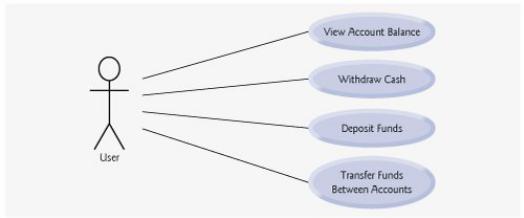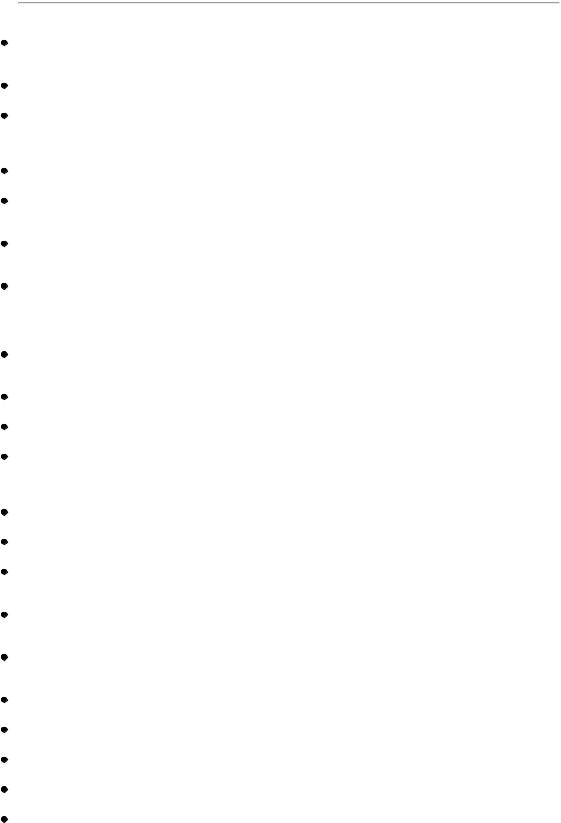
AhmadLang / Java, How To Program, 2004
.pdf
Software Engineering Case Study Self-Review Exercises
2.1 Suppose we enabled a user of our ATM system to transfer money between two bank accounts. Modify the use case diagram of Fig. 2.20 to reflect this change.
2.2 _____model the interactions among objects in a system with an emphasis on when these interactions occur.
a.Class diagrams
b.Sequence diagrams
c.Communication diagrams
d.Activity diagrams
2.3 Which of the following choices lists stages of a typical software life cycle in sequential order?
a.design, analysis, implementation, testing
b.design, analysis, testing, implementation
c.analysis, design, testing, implementation
d.analysis, design, implementation, testing
Answers to Software Engineering Case Study Self-Review Exercises
2.1 Figure 2.21 contains a use case diagram for a modified version of our ATM system that also allows users to transfer money between accounts.
Figure 2.21. Use case diagram for a modified version of our ATM system that also allows users to transfer money between accounts.
(This item is displayed on page 70 in the print version)
[View full size image]
2.2 b.

2.3 d.

[Page 69 (continued)]
2.10. Wrap-Up
You learned many important features of Java in this chapter, including displaying data on the screen in a command prompt, inputting data from the keyboard, performing calculations and making decisions. The applications presented here were meant to introduce you to basic programming concepts. As you will see in Chapter 3, Java applications typically contain just a few lines of code in method mainthese statements normally create the objects that perform the work of the application. In Chapter 3, you will learn how to implement your own classes and use objects of those classes in applications.

[Page 70]
Summary
Computer programmers create applications by writing computer programs. A Java application is a computer program that executes when you use the java command to launch the JVM.
Programmers insert comments to document programs and improve their readability. The Java compiler ignores comments.
A comment that begins with // is called an end-of-line (or single-line) comment because the comment terminates at the end of the line on which it appears.
Traditional (multiple-line) comments can be spread over several lines and are delimited by /* and */. All text between the delimiters is ignored by the compiler.
Javadoc comments are delimited by /** and */. Javadoc comments enable programmers to
embed program documentation directly in their programs. The javadoc utility program generates HTML documentation based on Javadoc comments.
A programming language's syntax specifies the rules for creating a proper program in that language.
A syntax error (also called a compiler error, compile-time error or compilation error) occurs when the compiler encounters code that violates Java's language rules.
Programmers use blank lines and space characters to make programs easier to read. Together,
blank lines, space characters and tab characters are known as white space. Space characters and tabs are known specifically as white-space characters. White space is ignored by the compiler.
Every program in Java consists of at least one class declaration that is defined by the programmer (also known as a programmer-defined class or a user-defined class).
Keywords are reserved for use by Java and are always spelled with all lowercase letters.
Keyword class introduces a class declaration and is immediately followed by the class name.
By convention, all class names in Java begin with a capital letter and capitalize the first letter of each word they include (e.g., SampleClassName).
A Java class name is an identifiera series of characters consisting of letters, digits, underscores
(_) and dollar signs ($) that does not begin with a digit and does not contain spaces. Normally, an identifier that does not begin with a capital letter is not the name of a Java class.
Java is case sensitivethat is, uppercase and lowercase letters are distinct.
The body of every class declaration is delimited by braces, { and }.
[Page 71]
A public class declaration must be saved in a file with the same name as the class followed by the ".java" file-name extension.
Method main is the starting point of every Java application and must begin with
public static void main( String args[] )

otherwise, the JVM will not execute the application.
Methods are able to perform tasks and return information when they complete their tasks. Keyword void indicates that a method will perform a task but will not return any information.
Statements instruct the computer to perform actions.
A sequence of characters in double quotation marks is called a string, a character string, a message or a string literal.
System.out, the standard output object, allows Java applications to display characters in the command window.
Method System.out.println displays its argument in the command window followed by a newline character to position the output cursor to the beginning of the next line.
Every statement ends with a semicolon.
Most operating systems use the command cd to change directories in the command window.
You compile a program with the command javac. If the program contains no syntax errors, a
class file containing the Java bytecodes that represent the application is created. These bytecodes are interpreted by the JVM when we execute the program.
System.out.print displays its argument and positions the output cursor immediately after the last character displayed.
A backslash (\) in a string is an escape character. It indicates that a "special character" is to be
output. Java combines the next character with the backslash to form an escape sequence . The escape sequence \n represents the newline character, which positions the cursor on the next line.
System.out.printf method (f means "formatted") displays formatted data.
When a method requires multiple arguments, the arguments are separated with commas (,)this is known as a comma-separated list.
Method printf's first argument is a format string that may consist of fixed text and format
specifiers. Fixed text is output by printf just as it would be output by print or println. Each format specifier is a placeholder for a value and specifies the type of data to output.
Format specifiers begin with a percent sign (%) and are followed by a character that represents the (-) data type. The format specifier %s is a placeholder for a string.
At the first format specifier's position, printf substitutes the value of the first argument after the
format string. At each subsequent format specifier's position, printf substitutes the value of the next argument in the argument list.
Integers are whole numbers, like 22, 7, 0 and 1024.
An import declaration helps the compiler locate a class that is used in a program.
Java provides a rich set of predefined classes that programmers can reuse rather than "reinventing the wheel." These classes are grouped into packagesnamed collections of classes.
Collectively, Java's packages are referred to as the Java class library, or the Java Application Programming Interface (Java API).
A variable declaration statement specifies the name and type of a variable.
A variable is a location in the computer's memory where a value can be stored for use later in a

program. All variables must be declared with a name and a type before they can be used.
[Page 72]
A variable's name enables the program to access the value of the variable in memory. A variable name can be any valid identifier.
Like other statements, variable declaration statements end with a semicolon (;).
A Scanner (package java.util) enables a program to read data for use in a program. The data
can come from many sources, such as a file on disk or the user at the keyboard. Before using a Scanner, the program must create it and specify the source of the data.
Variables should be initialized to prepare them for use in a program.
The expression new Scanner( System.in ) creates a Scanner that reads from the keyboard. The standard input object, System.in, enables Java applications to read data typed by the user.
Data type int is used to declare variables that will hold integer values. The range of values for an int is 2,147,483,648 to +2,147,483,647.
Types float and double specify real numbers, and type char specifies character data. Real
numbers are numbers that contain decimal points, such as 3.4, 0.0 and 11.19. Variables of type char data represent individual characters, such as an uppercase letter (e.g., A), a digit (e.g., 7), a special character (e.g., * or %) or an escape sequence (e.g., the newline character, \n).
Types such as int, float, double and char are often called primitive types or built-in types. Primitive-type names are keywords; thus, they must appear in all lowercase letters.
A prompt directs the user to take a specific action.
Scanner method nextInt obtains an integer for use in a program.
The assignment operator, =, enables the program to give a value to a variable. Operator = is
called a binary operator because it has two operands. A n assignment statement uses an assignment operator to assign a value to a variable.
Portions of statements that have values are called expressions.
The format specifier %d is a placeholder for an int value.
Variable names correspond to locations in the computer's memory. Every variable has a name, a type, a size and a value.
Whenever a value is placed in a memory location, the value replaces the previous value in that location. The previous value is lost.
Most programs perform arithmetic calculations. The arithmetic operators are + (addition), - (subtraction, * (multiplication), / (division) and % (remainder).
Integer division yields an integer quotient.
The remainder operator, %, yields the remainder after division.
Arithmetic expressions in Java must be written in straight-line form.
If an expression contains nested parentheses, the innermost set of parentheses is evaluated first.
Java applies the operators in arithmetic expressions in a precise sequence determined by the rules of operator precedence.

When we say that operators are applied from left to right, we are referring to their associativity. Some operators associate from right to left.
Redundant parentheses in an expression can make an expression clearer.
A condition is an expression that can be either true or false. Java's if statement allows a program to make a decision based on the value of a condition.
Conditions in if statements can be formed by using the equality (== and !=) and relational (>, <, >= and <=) operators.
An if statement always begins with keyword if, followed by a condition in parentheses, and expects one statement in its body.
The empty statement is a statement that does not perform a task.

[Page 73]
Terminology
addition operator (+) application argument
arithmetic operators (*, /, %, + and -) assignment operator (=)
assignment statement associativity of operators backslash (\) escape character binary operator
body of a class declaration body of a method declaration built-in type
case sensitive char primitive type character string class declaration class file
.class file extension class keyword
class name comma (,)
comma-separated list command line Command Prompt command window comment

compilation error compiler error compile-time error condition
%d format specifier decision
division operator (/) document a program double primitive type empty statement (;) end-of-line comment (//) equality operators
== "is equal to" != "is not equal to"
escape character escape sequence
false
fault tolerant
fixed text in a format string float primitive type
format specifier format string identifier
if statement import declaration
int (integer) primitive type integer
integer division
Java API documentation

Java Application Programming Interface (API)
Java class library
.java file extension
java command javadoc utility program
javadoc tool home page java.lang package Javadoc comment (/** */) left brace ({)
literal
location of a variable main method memory location message
method
modulus operator (%)
multiple-line comment (/* */) MS-DOS prompt
multiplication operator (*) name of a variable nested parentheses newline character (\n) object
operand operator optional package output cursor package parentheses ()
perform an action
